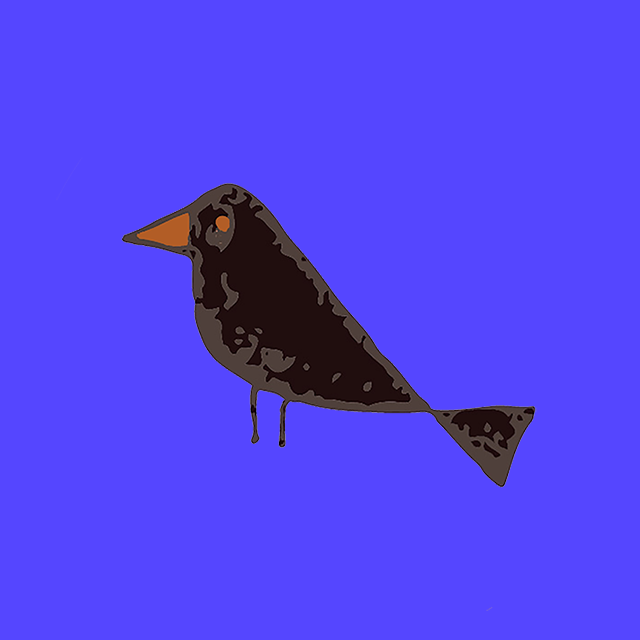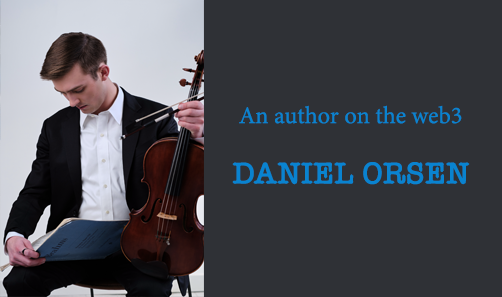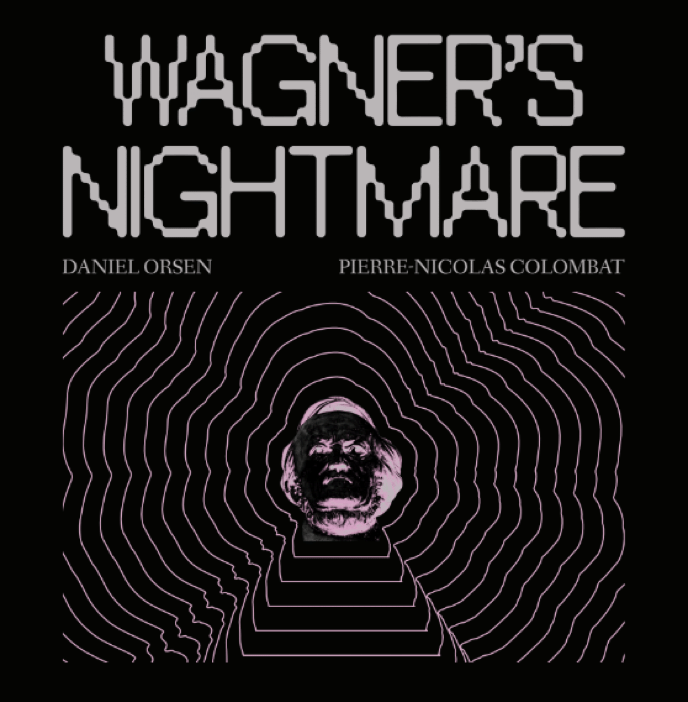
Feb 08•9 min read
DANIEL ORSEN... on the web3

I am an author on the web3, and I am so happy to introduce you today…
Daniel Orsen
#1 What does Art mean in your life?
I love music, which led me to play the piano, percussion, and viola as a kid. For one reason or another, viola stuck. I practiced four-hours a day, went to Oberlin Conservatory and New England Conservatory, and mucked-it out as a freelancer in Boston for four years after graduate school, which was an extremely difficult but invaluable experience. Now I am a member of the St. Paul Chamber Orchestra - a dream job that allows me to play orchestral, chamber, and solo repertoire, without having to constantly travel, and it leaves some time left over for independent projects, such as Wagner’s Nightmare.
[Don’t miss Daniel Orsen’s website]
#2 What place takes technology in your everyday life?
A very quotidian place! Technology is so pervasive and ubiquitous as to be unremarkable. I think many in my generation have disinterest in tech and internet things, more so than excitement or disgust, because we grew up with it and it is so omnipresent. However, I find the interaction between art and technology to be much more interesting. It certainly weighs more heavily on me.
Media, in the Greek sense of the-thing-in-between, has a profound affect on how audiences perceive art and ultimately on the art being produced. The new media that have arisen because of the internet have been challenging for classical music. In brief, I think they are inconducive for it, because the art-form demands focus, long attention spans, knowledge, discriminating taste, and community to get the most from it.
So from my position as an artist I find technology challenging - something that I have to creatively and begrudgingly make the best of.
#3 How did you discover blockchain tech? How did you decide to get into web 3? What would you recommend to newcomers?
Before we began work on the Wagner’s Nightmare album my collaborator and pianist, Pierre-Nicolas Colombat, was adamant about releasing the album in a way that stimulated a closer connection to a small network of fans and repeat interactions. At the very least he did not just want to put the album up on some streaming service where it would quietly be neglected and do nothing more than be a glorified business card.
So we began researching possible solutions. Over two days I talked with two of my cousins who work in tech. The first thing that came to mind for both of them was NFTs, even though they didn’t know all that much about them. The third day, by a chance occurrence, I met Domenic Salerni, the second violinist of Grammy-winning Attaca Quartet. I raised my quandary and, again, the first thing he mentioned was NFTs.
NFTs had gotten three hits in three days - so I knew I had to invest time into learning about them. I started watching videos, reading online articles (Ledger Academy is particularly clear and helpful) and listened to a lot of podcasts. I found NFTs for Newbies and The Gary Vee Experience to be helpful early on, and now that I have a base knowledge I prefer Daily Crypto Report and Overpriced JPEGs to keep tabs on what is going on in the web3 space.
The value that we see in NFTs, or Limited Digital Albums (LDAs) as we are dubbing them, is that they address the problem of digital scarcity. As of now, digital scarcity does not exist, which is a massive problem for musicians. When a recording is put up on Spotify, Apple Music, Youtube, or a social media platform, an infinite supply of it exists; it could be listened to an infinite number of times by an infinite number of people, which drives the amount of money musicians can make from their recordings through the floor - never mind the massive cuts that those platforms and record labels take.
An LDA creates digital scarcity.
By using blockchain technology it is possible to create digital assets of a finite supply. In the case of an LDA, that asset is a key which allows access to an album, such as Wagner’s Nightmare. As many or as few LDAs can be created as one wants: one, a hundred, a thousand, a million. But in all cases a finite number of keys are created. This is a revolution from the infinite supply that is currently the status quo of streaming and the internet in general. In our case a maximum of 1,000 LDAs (keys to access the Wagner’s Nightmare Album) will be created.
#4 Dapps
I use zero dApps at this point, unless we’re counting wallets and some NFT marketplaces. For me the creation is all in performing and recording, so there is nothing a dApp can do for me in those regards. My main interest with NFTs and blockchain is distribution. We are fortunate with Wagner’s Nightmare to have two developers working to create a minting page directly on our website so we don’t have to go through any dApps to release the album.
#5 Tell us about your projects in the real world and on the web3
In the real world my main gig is as a violist with the St. Paul Chamber Orchestra. Wagner’s Nightmare has a web3 element of course, since that is how we are releasing the album, but it is also a real world thing since we do concerts and talks, and the work behind the scenes is also very much real world.

Wagner’s Nightmare is a tongue-in-cheek send-up to the most controversial composer of all time, Richard Wagner. And it is a gesamtmediaproject of sorts. Wagner’s Nightmare germinated from the fact that Richard Wagner did not like the viola, so much so that he had an alternative (bigger) version of the instrument, called the Viola Alta, built for his orchestra at Bayreuth. That gave rise to the idea for an album of music for viola and piano that Wagner wouldn’t like, and included things like Mendelssohn’s Viola Sonata, songs by Friedrich Nietzsche, arrangements of Satie, and of course, some Wagner.
Wagner is infamous for not liking things, so from the idea of an album of music of Wagner wouldn’t like, we expanded to a full tilt project of studying Wagner via things he did not like. An expanding list of topics which includes The Viola, Nietzsche, Westerns, Antisemitism, Liszt, and soon Hunting and The French, can be found on our website, WagnersNightmare.com. For each topic we have written, video, and musical materials. We also have a podcast where we keep tabs on our project and discuss Wagner-related topics with philosophers, musicians, and historians. But the culmination and cornerstone of Wagner’s Nightmare is above all the album, which will be released Thursday, February 16, as an NFT.
We are actually dubbing the release method a “Limited Digital Album” because there is an intense negative stigma in the classical music world (and society in general) around “NFTs.” It also better reflects exactly what it is we are trying to do with the technology. Our method is to have a minting page directly on our website where listeners can mint an NFL which is essentially a key to gain access to the album. From there they can download the album and listen to it however they want. Only 1,000 such keys will be available for mint.
#6 About NFTs: What is your opinion about Digital Collectibles? From your experience what are the pros and the cons?
I think the concept of what NFTs or Digital Collectibles are or can be is too narrow. I like to think of them as digital assets, and there are potentially as many kinds of digital assets as there are physical assets. My attention has been narrowly focused on how I can use NFTs as a musician for distribution.
I also think NFTs are good for fans because there is something about owning a recording that increases one’s engagement with the music and what one gets out of it. So NFTs as a distribution method/medium is win-win for musicians and listeners. It’s a win for musicians financially, and a win for listeners artistically.
#7 About your community. Do you have a community, an audience, a group of followers in the digital world? How do you manage the relationships with your connections?
The community I have in the digital world is largely a carry-over from the physical world. I think this is the case with most musicians. People engage most deeply at concerts, and then might continue to follow through the digital world.
This is one of the major challenges of being a classical musician in web3. The “web3 people” tend not to be very interested or engaged with classical music, and the “classical music people” are slow to even dip their toes in web3 waters. It’s an uphill battle both ways. But I do believe it’s a better method of releasing music that streaming, and its time will come for all genres of music.
#8 About the future of Art on the web. As an artist, what are your expectations for your work on the web in the upcoming years?
As a classical musician, what artistically matters most is live performances.
The internet, whether web2 or web3, is really about advertising, communications, and distributing recordings; recordings being a different medium than live performance. I mostly see myself continuing to hone web3’s power to distribute recordings in a manner that remunerates artists better, creates a deeper connection to fans, and more value for listeners.
To that end, I would like to lead my ensemble, the St. Paul Chamber Orchestra, into being one of the early adopters of blockchain technology in the orchestral world.
If anyone in the Smartists community or anyone reading this would like to be on the Whitelist for the Wagner’s Nightmare LDA, please email your names at the address for an Ethereum compatible wallet to [email protected]. The Whitelist mint will be on Wednesday, February 15, and will be approximately $25 USD, which is $10 less than the general mint.
